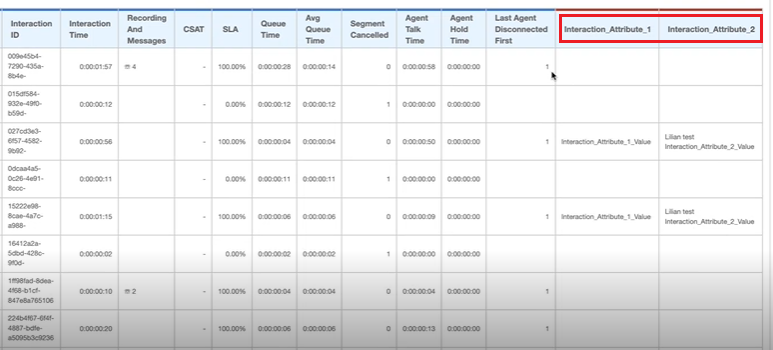Release Notes for 2023
The release notes contained on this page reflect the changes made to CxEngage and CxQM in 2023, excluding the most recent releases.
For release information regarding the most current releases, see the What's New. For other release information, categorized by year, see Archived Release Notes.
| CxEngage Release 23.11.29 | |
|---|---|
| All Regions | November 29, 2023 |
Update: Data Complete Flag in Interactions API
Previously, when an End Timestamp was available on the interactions API, the interaction was considered complete and ready to be processed by other applications, such as a Business Intelligence utility. Because Wrap Up activities and other post-conversation events take place after an End Timestamp is logged, some information was not included when interactions were processed before post-conversation values were updated.
So that you can ensure that an interaction is complete and ready to be reviewed or processed, a new dataComplete parameter has been added to the Interactions API.
The dataComplete parameter can have a value of true-the interaction is complete, or false-the interaction is not complete and is found in all historical APIs.
Update: Allow Zero CSAT Score
An enhancement to the Customer Satisfaction Score collection configuration allows you to accept zero (0%) as a customer response. To enable your score range to begin at 0%, toggle the Allow Zero Score setting to On in the Customer Satisfaction Score parameters. CxEngage will accept an input of 0 up to the Max Score you define in the parameters.
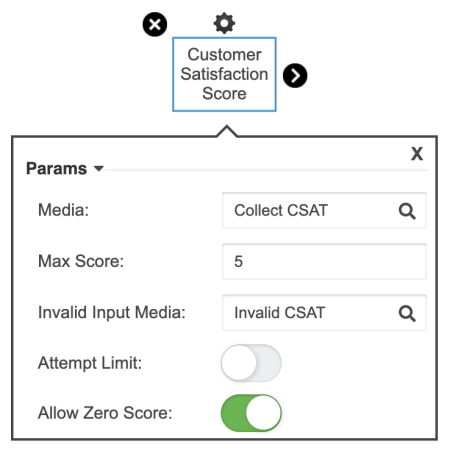
Note: Temporarily, zero % CSAT scores display as % in reporting, with no number in front of the %. Calculations using zero scores are accurate. The display of 0% in reporting will be updated in a future release.
Fix: CSAT Notation is Accepting Improper Values (CXV1-30001)
Previously, the defined parameters for collecting the CSAT score were not being honored.
When the customer exceeded the defined Maximum Attempts to enter a CSAT score or entered a value higher than the allowed Max Score, CxEngage still saved the last entered value.
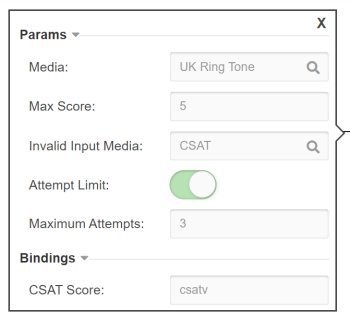
This issue has been fixed. If the customer exceeds the maximum number of attempts or the last attempt exceeds the maximum score allowed, CxEngage disregards the entry (entries) and does not save the CSAT score.
| CxEngage Release 23.11.22 | |
|---|---|
| All Regions | November 22, 2023 |
Fix: Permission "View Skill" doesn't show the agents assigned to each skill (CXV1-29950)
To limit the ability of non-supervisor and non-administrator roles seeing information they do not have access to, the permissions for viewing skills and the users that are assigned to those skills have been updated, and a new permission has been added. All permissions listed below are in the Administrator and Supervisor roles by default. You can assign any of these permissions to custom roles in your tenant.
-
VIEW_ALL_SKILLS - allows you to see the skills that are available on the tenant.
-
VIEW_ALL_SKILL_USERS - allows you to see the users assigned to a specific skill in User Management > Skills.
-
VIEW_ALL_USER_SKILLS - allows you to see all skills assigned to a user on their user profile in User Management > Users.
Note: The VIEW_ALL_SKILLS permission no longer allows you to see the users who have the skill assigned.
| CxEngage Release 23.11.18 | |
|---|---|
| All Regions | November 18, 2023 |
Update: Sorting Agents By Skill During Allocation
The new Sort by Proficiency feature allows administrators to base the assignment of an interaction to an agent on the sorting criteria that is defined in the queue.
Currently, during agent allocation, proficiency is only used to filter agents by skill level. Agents that do not meet a specific criteria are weeded out of the list before a call is routed to them. Then, an agent is assigned the interaction based on the longest idle time.
When the new sorting feature is used, after all skill filters are applied, the interaction is assigned to an agent based on how their skills align with the skill sort order defined by the administrator.

For example, the Skill Filters in this queue require that an agent have All of these skills: a proficiency of at least 3 in Skill 1 AND a proficiency of at least 2 in Skill 2. As well, the agent can have Any of these skills: a proficiency of at least 1 in Skill 3.
When Sort by Proficiency is enabled, the administrator defines which of the three skill requirements should be met first and in which order, ascending or descending. The agent who is first eligible to be assigned the interaction is the one who meets the Sort by Skills criteria and then the longest idle time.
Note: Sort by Proficiency is only available with Advanced Routing. Contact your Customer Service Manager for more information.
For information on setting up your queues to sort by proficiency, see Creating Queue Queries using the Basic Query Builder
| CxQM Release 23.11.04 | |
|---|---|
| All Regions | November 04, 2023 |
Update: Searching for Interactions Using Disposition Codes
The enhanced CxQM custom search engine lets users search recorded interactions based on standard CxEngage attributes, such as Group Name, Group Id, and Queue Id, custom attributes that are defined in your interaction flow, and now disposition codes. This new functionality lets supervisors and managers focus their search on the most critical interactions, some of which include custom disposition codes.
Note: This functionality may not be enabled. Please contact support if you want to turn this feature on.
Creating Disposition Codes
Before you are able to search on disposition codes in CxQM, you must first create your disposition codes and disposition lists, and then add them to your interaction flow.
Note: For information on Working with Dispositions and Disposition Lists, see the online help. For information on adding the disposition to your interaction flow, see the Flow Designer Reference.
Configuring Playback View to Display Dispositions
To manage the information that supervisors and managers can see and search on when reviewing recordings, you can manage which columns they can display at Quality Management > Administration > Setup > Display Settings > Configure Default Playback View.
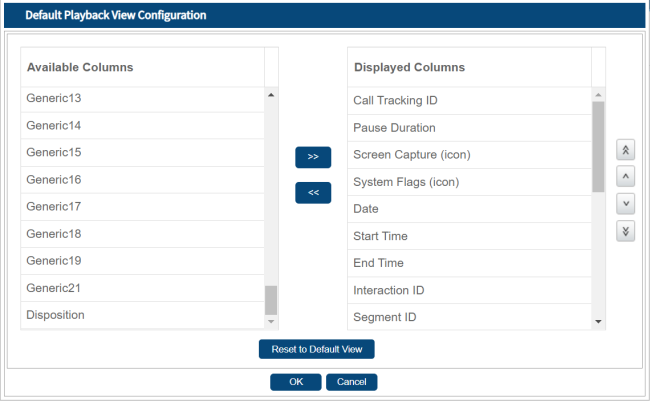
Disposition is automatically added to the Available Columns list on the Default Playback View Configuration dialog. For supervisors and managers to see and search on the information, you must display the information to them. To display disposition codes, click on it in the Available Columns list and move it to the Displayed Columns list. Click OK to save your changes.
Important: If you do not add Disposition to the Displayed Columns list, your users will not be able to see or search on them in CxQM.
Note: When reviewing recordings, users can choose which columns to show across the page. To display a column, click Playback Options settings, select My View, click the Columns arrow, and then check the box for each column to show on the page. The user can uncheck the box for any column to hide it from view.
Searching Recordings by Disposition
To search for recordings with specific disposition values, when on the Quality Management > Recordings > Playback tab, click Custom Search. On the Custom Search Criteria dialog, click the Options tab. Click the Disposition arrow and select the Disposition value by which you want to filter the recordings. Click OK to run the search and view the results.
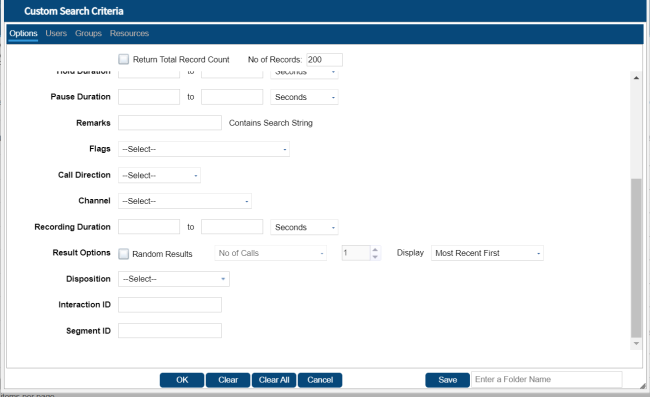
Important: You can only search disposition values for interactions after the feature is enabled with this release. This search does not apply to historical data.
Note: Save your custom search and you can return to it and run it against the interactions list at any time.
| CxQM Release 23.10.18 | |
|---|---|
| All Regions | October 18, 2023 |
Fix: Screen Capture Stopping for Agents (CXV1-30032)
An intermittent issue that stopped the screen capture application from properly handling recordings has been resolved.
The problem occurred when the screen capture application did not transition into the correct recording state. This issue impacted current and future recordings. The screen capture application now gracefully handles failed recording transition states so that captures start correctly and subsequent recordings work as expected.
| CxEngage Release 23.10.14 | |
|---|---|
| All Regions | October 14, 2023 |
Fix: Camelcasing entity names in table drop-down filter
Previously, the first letter of an option in a drop-down list was automatically capitalized by CxEngage, even when the option purposely contained a lowercase letter at the beginning.
Users specifically saw this issue in the Groups, Skills, and Roles drop-downs on the User Management > Users page and in the Queue drop-down on the Reporting > Interaction Management page.
This has been corrected. All drop-down list options in CxEngage now display exactly as created. If an option begins with a lowercase letter, it displays as such in the drop-down list.
| CxEngage Release 23.10.07 | |
|---|---|
| All Regions | October 07, 2023 |
Update: Alphabetical sorting in dropdowns
The Queues drop-down menu on the Reporting > Interaction Management page and the Skills drop-down menu on the User Management > User page are now sorted alphabetically. Also, when creating a disposition list item for a disposition list, the Disposition drop-down menu is now sorted alphabetically.
Fix: Select all function not working in Agent State Monitoring
Previously, in CxEngage Realtime Dashboard, in Agent State Monitoring, users were unable to select or deselect the All option when attempting to perform a bulk update for all visible agents. Also, the Work mode and Presence state drop-down menu options were unavailable. These issues have been fixed.
| CxEngage Release 23.09.23 | |
|---|---|
| All Regions | September 23, 2023 |
Update: Reporting API Retrieves Outbound Identifiers
Fields have been added in /interactions API payload for new interactions that use Outbound Identifiers with channelType "Email", "Voice", and "SMS".
The API response for parameter "outboundIdentifiers" can include the following:
| Parameter | Description |
| interactionOutboundIdentifierId | The unique Id of the interaction outbound identifier. |
| outboundIdentifierId | The unique Id of the outbound identifier. |
| outboundIdentifierValue | Can be a phone number or an email address, based on the channelType of the interaction: voice, sms, or email. |
| outboundIdentifierName | The description of the outboundIdentifier. |
When the outboundIdentifier parameter is included in a response, it might look as follows.
"outboundIdentifiers": [
{"interactionOutboundIdentifierId": "52e507c0-4e6c-11ee-ad38-8a8e9f703fd3",
"outboundIdentifierId": "8a13f0b0-d97f-11ed-b23a-81a455430a6f",
"outboundIdentifierValue": "+17254000678",
"outboundIdentifierName" "SMS 2"
}
]
| CxQM Release 23.09.16 | |
|---|---|
| All Regions | September 16, 2023 |
Update: Searching for Interactions Using Custom Attributes
The enhanced CxQM custom search engine now lets users search recorded interactions based on not only standard CxEngage attributes, such as Group Name, Group Id, and Queue Id, but also on custom attributes that are defined in your interaction flow. This new functionality lets supervisors and managers create an array of custom parameters and then concentrate their searches on those key business identifiers, allowing them to focus on the most critical interactions.
Note: This functionality may not be enabled. Please contact support if you want to turn this feature on.
Creating Custom Attributes
Before you are able to search on custom attributes in CxQM, you must first create your attributes and then add them to your interaction flow.
Note: For information on Creating Custom Interaction Attributes, see the online help. For information on adding the attribute to your interaction flow, see the Flow Designer Reference.
Configuring Playback View to Display Custom Attributes
To manage the information that supervisors and managers can see and search on when reviewing recordings, you can manage which columns they can display at Quality Management > Administration > Setup > Display Settings > Configure Default Playback View.
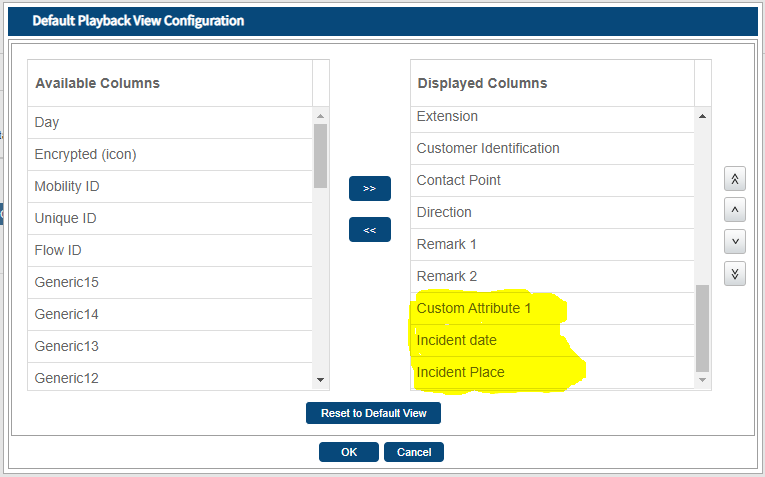
Custom attributes are automatically added to the Available Columns list on the Default Playback View Configuration dialog. For supervisors and managers to see and search on the information, you must display the information to them. To display a custom attribute, click on the attribute in the Available Columns list and move it to the Displayed Columns list. Click OK to save your changes.
Important: If you do not add the custom attribute to the Displayed Columns list, your users will not be able to see or search on the attribute in CxQM.
Note: When reviewing recordings, users can choose which columns to show across the page. To display a column, click Playback Options settings, select My View, click the Columns arrow, and then check the box for each column to show on the page. The user can uncheck the box for any column to hide it from view.
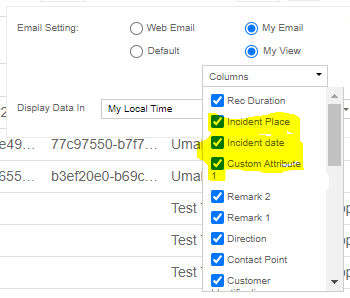
Searching Recordings by Custom Attributes
To search for recordings with specific custom attribute values, when on the Quality Management > Recordings > Playback tab, click Custom Search. On the Custom Search Criteria dialog, click the Custom Attributes tab. The available custom attributes display. In the appropriate custom attribute field, enter the information by which you want to filter the recordings. Click OK to run the search and view the results.
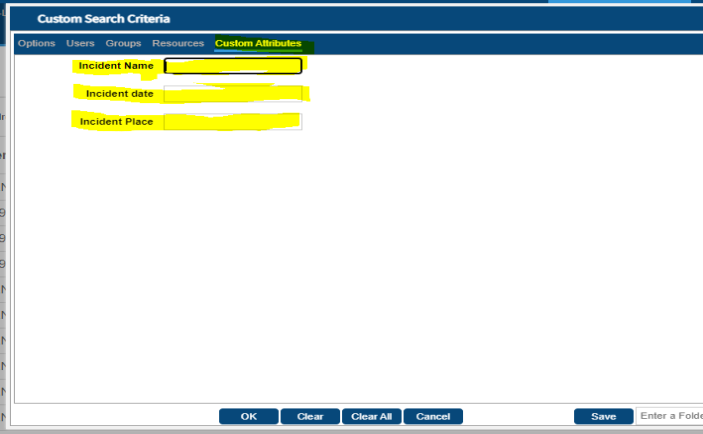
Important: You can only search custom attribute values for calls received after enabling the feature. This search does not apply to historical data.
Note: Save your custom search and you can return to it and run it against the interactions list at any time.
| CxEngage Release 23.08.30 | |
|---|---|
| All Regions | August 30, 2023 |
Fix: CxE ConfigUI Updates Dispatch Mappings with the Same Configurations (CXV1-28931)
Previously, it was possible to update and enable multiple dispatch mappings with the same channel type, mapping, and mapping value. This was causing confusion when determining which flow to dispatch.
Validation has been added so that if identical dispatch mappings exist - same channel type, mapping, and mapping value, only one can be enabled at a time.
| CxEngage Release 23.08.26 | |
|---|---|
| All Regions | August 26, 2023 |
Fix: Issue Creating Voice Transfer List to Queue on Tenant (CXV1-29103)
Previously, when adding a voice transfer list for Queue, the new list would not save to the tenant. This issue has been fixed.
| CxEngage Release 23.08.19 | |
|---|---|
| All Regions | August 19, 2023 |
Update: Changes to Twilio Voice Media IP Addresses
Effective October 10, 2023
To improve flexibility, reliability, and scalability, Twilio will update the media IPs and port ranges used for Elastic SIP Trunking, Programmable Voice SIP, Flex, or Voice SDK, in all regions. This improvement will result in a single global IP range, 168.86.128.0/18, rather than multiple regional ranges. Also, the media port range will expand from 10000-20000 to 10000-60000.
When the new global IP and port range becomes active, the regional IPs and port ranges will no longer work. For your calls to continue to connect properly, you must update your Twilio firewall settings to allow the new IP and port range. If you fail to make this update, you will experience one-way audio and dropped calls.
When: Before October 10, 2023
Updates to Firewall Settings:
-
IP range: 168.86.128.0/18
-
UDP port range: 10000-60000
Important: Prior to October 10, 2023, continue to use the information found in the CxEngage Online Help at: Getting Started > System Requirements > Firewall and Proxy Configuration > WebRTC (Twilio Requirements) to identify the Twilio firewall settings for your region. However, after October 10, 2023, you may remove old IPs and port ranges.
Note: Currently, plans are for changes to Twilio Voice Interconnect Media IP addresses to take effect February 21, 2024.
Update: Interaction Segment Analysis Timing Out (CXV1-28864)
When exporting the Interaction Segment Analysis report to Excel or PDF, a timeout error occurred. The time it takes to extract the Interaction Segment information as been reduced, allowing for the export to be completed correctly.
Update: Shared Analysis - Resume Functionality (CXV1-29612)
Previously an enhancement was added to CxEngage which opened reports in a paused state. This enabled the user to make changes to the report before retrieving the data. This functionality has been added to shared analyses. When a shared Analysis report is opened, data retrieval is paused and a Resume button displays on the screen. When the user clicks the button, the data retrieval starts and the Pause Data Retrieval button displays.
Fix: Interaction Detail by Queue Reports Queries Pulling Data Haphazardly (CXV1-27520, CXV1-27521, CXV1-27523)
SLA Denominator and Queue Entries columns displayed incorrect information in the Interaction Detail by Queue report. This has been corrected. These columns now display "1" for a true value and a "0" for blank.
Fix: Shared With Me Folder Shows User ID (CXV1-29774)
In Historical Reporting when you hovered over a shared item in the Shared with Me folder, the user ID displayed. This has been changed so that when you hover over a shared item the user name displays.
| CxEngage Release 23.08.09 | |
|---|---|
| All Regions | August 09, 2023 |
Fix: No longer able to download calls with Salesforce URL link (CXV1-29967)
Previously, an error was received when downloading recorded messages using the URL link in Salesforce. This issue has been resolved.
Fix: Multiple users are getting error - 7019 (CXV1-29975)
Some users received Code: 7019 errors when attempting an outbound call. This issue has been resolved.
| CxEngage Release 23.07.26 | |
|---|---|
| All Regions | July 26, 2023 |
Maintenance: Email-gateway
General maintenance on email-gateway to improve performance and backward compatibility.
Maintenance: CxEngage
General maintenance on CxEngage to improve performance.
| CxEngage Release 23.07.22 | |
|---|---|
| All Regions | July 22, 2023 |
Fix: Roles Require MANAGE_ALL_MEDIA Permission (CXV1-28238)
Previously to see the User Management > Skills and User Management > Groups menu options in CxEngage, user roles were required to have the following permissions, based on what the user was allowed to do.
User Management > Skills
-
MANAGE_ALL SKILLS - required to manage skills in CxEngage
-
VIEW_ALL_SKILLS - required to view the list of skills in CxEngage
-
MANAGE_ALL_MEDIA - required to manage or view skills in CxEngage
User Management > Groups
-
MANAGE_ALL_GROUPS - required to manage groups in CxEngage
-
VIEW_ALL_GROUPS - required to view the list of groups in CxEngage
-
MANAGE_ALL_MEDIA - required to manage or view groups in CxEngage
The requirement to have the MANAGE_ALL_MEDIA permission has been removed. Roles no longer need this permission to see the Skills or Groups menu option under User Management.
Note: Roles must still have the appropriate MANAGE_ALL_SKILLS/GROUPS or VIEW_ALL_SKILLS/GROUPS permissions.

| CxEngage Release 23.07.15 | |
|---|---|
| All Regions | July 15, 2023 |
Update: Agents Can Change the FROM/Reply As Address in an Email Interaction
Previously in Skylight, agents could only send emails using the single SMTP User email address that is part of the Email Integration in CxEngage.
Now, when an agent replies to an email interaction, a different Outbound Identifier can be selected from a list of multiple email addresses. This email address displays to the customer as the FROM address in the message. Also, when the customer selects Reply, that different email address displays in the TO field.
Important: Before configuring the multiple reply email feature, the tenant must have a Flow and Dispatch Mapping for Outbound Email.
An administrator or supervisor must do the following configurations before the agent can select a different Reply As email address for the interaction.
-
Create your Outbound Identifiers, which are the email addresses that you want to include as a Reply As in your email interaction. See the Creating Outbound Identifiers page in the online help for detailed instructions.
-
Create your Outbound Identifier List containing all the Outbound Identifiers you want available as the Reply As email addresses. See the Creating an Outbound Identifier List page in the online help for detailed instructions.
-
Assign the Outbound Identifier List to the agents, skills, and groups that you want to be able to see the Outbound Identifier List in Skylight. See the Assigning Outbound Identifiers page in the online help for detailed instructions.
-
So that Skylight can receive and send emails using different email addresses, assign and enable each Outbound Identifier to the Listener list in the CxEngage Email Integration. For detailed instructions, see the Listeners section of the Creating Integrations page in the online help.
Once you have completed these steps, agents given the proper permission can choose a different Reply AS email address during an interaction in .
To change the FROM address when replying to an email interaction, the agent will do the following:
1. In , when a notification is received that an email interaction is available, accept the work.
2. After reviewing the email, click Reply.
3. Enter a response and make any necessary updates.
4. Click the Reply As arrow and select from the list the email address to be used as the Reply As address—the Reply As email address in the email area changes to reflect the one chosen by the agent.
Note: You can also change the Reply As email address on the Info panel.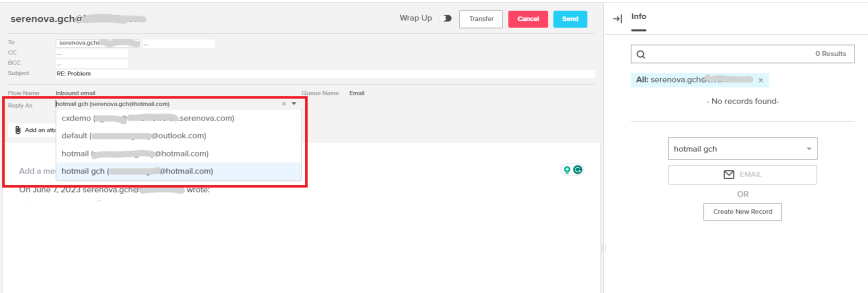
5. Click the Send button.
To change the FROM address when creating a new email interaction, the agent will do the following:
1. In , click the New Interaction icon.
2. Enter the contact's email address in the Search field.
3. Press the Enter key on the keyboard.
If the email already exists as a contact, the contact information displays.
4. Click the contact's email address.
5. If an Outbound Identifier List exists, the agent can select a different Reply As address. Click the Select Reply As arrow and then select the email address to use as the Reply As email.
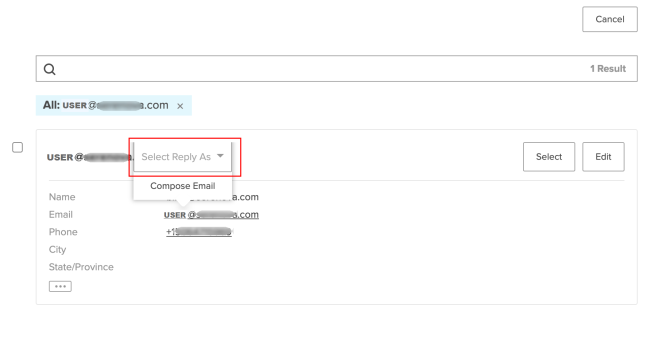
6. Click Compose Email. The Compose Email window opens with the contact's information in the appropriate fields and the selected email address as the Reply As address.
Note: If the Reply As address is incorrect, cancel the interaction and re-initiate the email or on the Info panel click the email address, click Select Reply As and then select the correct email address.
If the email does not exist as a contact, the email address shows beneath the Search field with no other contact information.
4. Click the Select Reply As arrow and select from the list the email address to be used as the Reply As address.
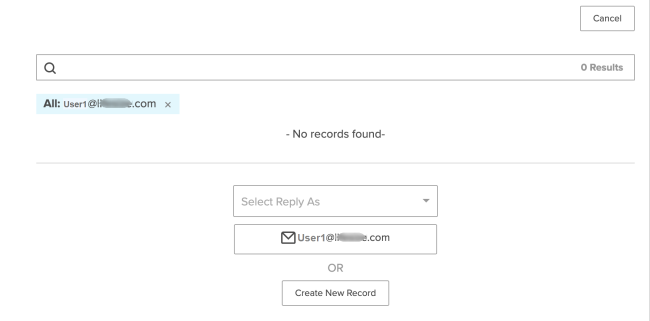
5. Click the button that reflects the user's email address. A new email interaction opens with the email address in the To field and the selected Reply As email address.
Note: If the Reply As address is incorrect, cancel the interaction and re-initiate the email or on the Info panel click the email address, click Select Reply As and then select the correct email address.
Send the email with the different Reply As address.
Finally, enter a message, make any necessary updates, and click the Send button to complete the new email interaction.
Warning: If you previously set a From address in the Click to Email flow, ensure the address is the SMTP-User email address found in the Email Integration or any active Listener. Otherwise, the Send mail function will not work.
No matter which circumstance prompts the interaction, when the customer receives the email, the FROM address reflects the Reply As email address that the agent selected when creating the interaction. When the customer clicks Reply, the Reply To address reflects the chosen email address as well.
Note: This feature requires the SMTP User in the email integration's properties to have an active listener configured for that SMTP User. If you have any difficulties please reach out to your system administrator or support representative.
Update: New Data Dictionary is Live in the Online Help
A new version of the data dictionary is online. You can view the revised information in the CxEngage online help at Reporting > Data Dictionary. Information is sorted by the data set that it is part of and by statistic name. You can also use a keyword search to find specific information. The data dictionary is a work in progress and will be continuously updated. If you are unable to find information that you need, please log a support ticket so that we can improve the data dictionary content.
| CxEngage Release 23.06.14 | |
|---|---|
| All Regions | June 14, 2023 12:00 - 15:00 UTC |
Fix: Exit Queue does not Dequeue and Remove from Journal (CXV1-29811)
Previously interactions that were removed from a queue using the Exit Queue notation were left in the queue journal, preventing them from being re-enqueued to the same queue they had previously entered. This has been resolved and interactions that are removed from a queue using the Exit Queue notation can now be re-enqueued to any queue necessary, including previous queues to which that interaction was sent.
| CxEngage Release 23.04.19 | |
|---|---|
| All Regions | April 19, 2023 12:00 - 15:00 UTC |
General Maintenance: OAuth Not working when O365 is set to require approval (CXV1-29468)
When updating or creating an email integration with an O365 account, you can view the permissions that Lifesize requires for the CxEngage Email Integration to work correctly. Click the "By signing in with Microsoft you are approving these permissions" link to see the permissions Lifesize requests.
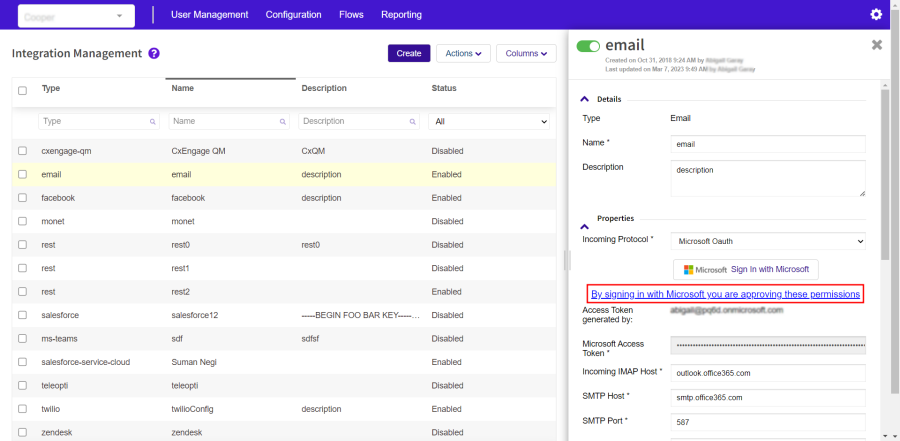
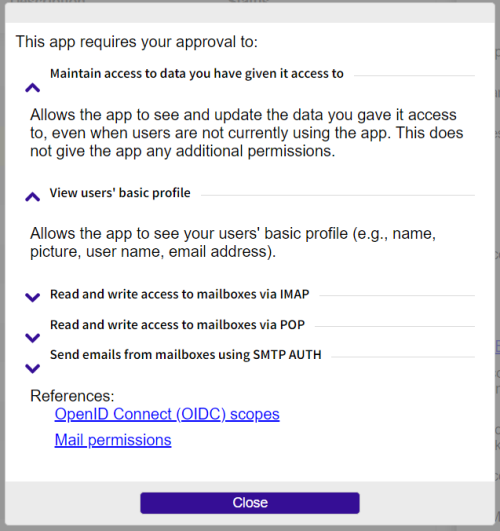
| CxEngage Release 23.04.12 | |
|---|---|
| All Regions | April 12, 2023 12:00 - 15:00 UTC |
General Maintenance: Removing Early Access Features (CXV1-29523 )
A feature that previously allowed users to enable and disable specific features in CxEngage in order to return to a previous application version has been removed. Now, all customers will run the latest version of the application.
General Maintenance: Sliding Columns in Real Time Tables Overlap Data (CXV1-29773)
Ellipses (…) now display at the end of information when there is more data to present than the width of the column allows. To see all of the information, expand the column.

| CxEngage Release 23.03.29 | |
|---|---|
| All Regions | March 29, 2023 12:00 - 15:00 UTC |
General Maintenance: Enhancements to Reporting
General improvements have been made to Reporting. Enhancements include showing the name of the user who shared a report with you when you mouse over the report name and optimizing joins for the following reports:
-
Interaction Summary
-
Interaction Summary By Flow
-
Abandoned Channel By Day
-
Interaction Summary By Contact Point
-
Interaction Detail
Note: The User ID is still shown when you mouse over a shared folder.
| CxEngage Release 23.03.18 | |
|---|---|
| All Regions | March 18, 2023 12:00 - 15:00 UTC |
Update: Exposing Email Information to Flow
An update has been made to allow access to email information in Flow Designer for interactions on the Email Channel. This will allow call flow designers to pull in this data to be used elsewhere in call flows.
This data can be accessed with the following values:
| Name | Description | Example |
|---|---|---|
| interaction/interaction.to |
The To addresses for the email interaction. |
(= interaction/interaction.to.0.address "name@company.com") |
|
interaction/interaction.cc |
The CC addresses for the email interaction. Can return multiple values in a map |
(= interaction/interaction.cc.0.address "name@company.com") |
| interaction/interaction.bcc | The BCC address for the email interaction. | (= interaction/interaction.bcc.address "name@company.com") |
| interaction/interaction.from | The From address for the email interaction. | (= interaction/interaction.from "name@company.com") |
| interaction/interaction.body | The Body of the email interaction. | (= contains? interaction/interaction.body "support") |
Fix: Realtime Dashboards Unable to Adjust Field Size (CXV1-29490)
An issue where column sizes on Realtime Dashboards could not be modified has been fixed.
The fields sizes can now be adjusted in the Realtime and Custom Dashboards.
| CxEngage Release 23.03.04 | |
|---|---|
| All Regions | March 04, 2023 12:00 - 15:00 UTC |
Update: Adding Maximum Retries Criteria to CSAT Flow
Currently, when the Customer Satisfaction Score is called in the Flow Notation, and the customer fails to enter a value, the flow continues to try and collect the information until the customer disconnects.
This update allows you to specify a maximum number of times to attempt the collection of a value. When the maximum number of retries is met, the Customer Satisfaction notation is bypassed leaving the customer connected.
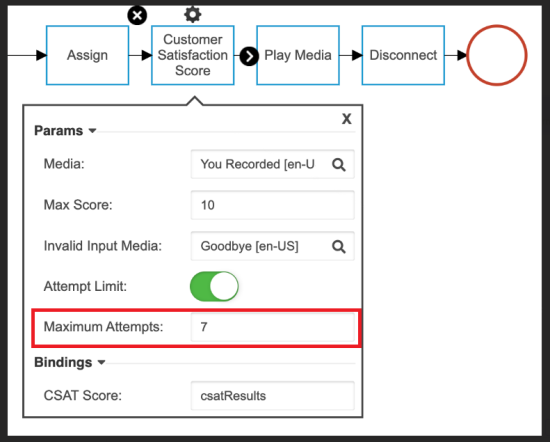
Update: Global Filter Performance (CXV1-29492)
Standard maintenance to the reporting tools has improved reporting performance.
Fix: Opening a Flow in a New Tab Re-directs to the Log In Screen (CXV1-28725)
When attempting to view a flow in a new tab, the user is redirected to the Login screen. This issue has been fixed so that when you right-click the View Flow button and click Open in new tab, the flow opens in a new tab.
Fix: Interaction Management Table Crashing (CXV1-29476)
An error that intermittently occurred on the Reporting > Interaction Management page has been fixed.
| CxQM Release 23.02.25 | |
|---|---|
| All Regions |
February 25, 2023 12:00 - 15:00 UTC |
Fix: CxQM Not Showing All Agents By Default (CXV1-29455)
An issue was found that when you opened an evaluation and searched for agents, not all the expected agents were included in the results. This issue has been fixed. All agents that meet the search criteria are now reflected in the search results.
| CxEngage Release 23.02.11 | |
|---|---|
| All Regions | February 11, 2023 12:00 - 15:00 UTC |
Fix: Stale Sessions Causing Transfer Errors (CXV1-28530)
An issue where agents with stale sessions could sometimes make transfers unavailable across the tenant has been fixed.
| CxEngage Release 23.02.8 | |
|---|---|
| All Regions | February 8, 2023 12:00 - 15:00 UTC |
Fix: Improve Reporting Performance for Custom Attributes (CXV1-29007, CXV1-29474)
Users should experience a quicker response when reporting with custom attributes. This includes the following reports:
-
Interaction Detail by Agent
-
Interaction Detail by Queue
| CxEngage Release 23.02.4 | |
|---|---|
| All Regions | February 4, 2023 12:00 - 15:00 UTC |
Fix: Aligning Dashboard and Table Columns Properly (CXV1-29509)
Previously some dashboards and management tables in CxEngage appeared misaligned. Information in the grid did not display directly under the appropriate column header.
This issue was found in, but was not necessarily limited to, the following areas:
-
Queue Management Tab
-
Media Management Tab
-
Custom Realtime Dashboards Tab
-
Realtime Dashboard > Agent Details Table
-
Realtime Dashboard > Agent State Table
-
Realtime Dashboard > Interaction State Table
-
Realtime Dashboard > Interactions Completed Table
This issue has been corrected and the dashboards and tables now display properly.
| CxEngage Release 23.01.21 | |
|---|---|
| All Regions | January 21, 2023 12:00 - 15:00 UTC |
Update: Added Wrap-Up Indicator (CXV1-28959)
In , agents can see if another agent is in wrap up status or if they are available for a transfer call.
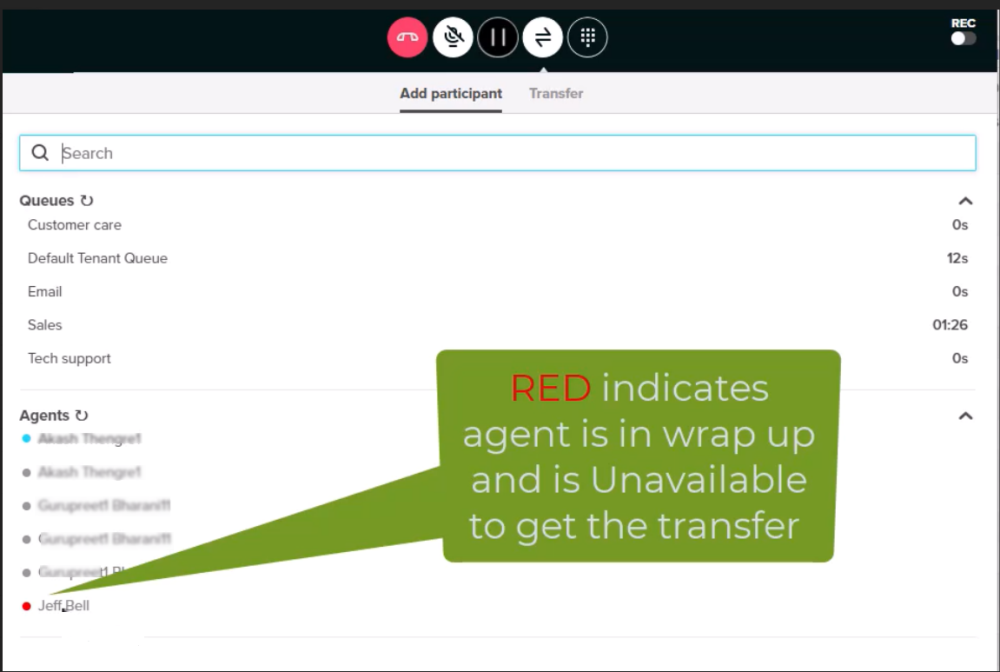
Update: Update OAuth Token in Email Integration and Listener (CXV1-28874)
When you use Microsoft OAuth as the protocol for your Email integration and an access or refresh token is updated, the Microsoft Access Token for the CxEngage Email integration and Listener are automatically updated.
Update: Interaction State Added to Realtime Dashboards. (CXV1-28960)
A new table, Interaction State List, has been added to Reporting > Realtime Dashboards and Custom Realtime Dashboards. This list contains both wrap-up and hold time, along with information such as agent, channel, and call state.

Update: Monitoring Digital Channel Interactions (CXV1-28785)
The Interaction Monitoring page found at Reporting > Interaction Monitoring now includes information for digital channels. You can review multiple messaging interactions at one time; this includes interactions such as web chat and Facebook Messenger.
Some things you may notice include the following:
-
You can filter the Channel column by "messaging."
-
You can collapse sections on the page, such as Interactions Detail, Active Participants, and Interaction Monitors so interactions can be found easily.
-
You can click the End Monitoring button to end a monitoring session quickly.
-
You can view the digital transcript for the interaction.
Note: You cannot monitor digital interactions in real-time. The transcript is updated every 10 seconds for new messages. As well, messaging interactions are read-only.
-
New interactions display a blinking red indicator rather than the typical down arrow. After you expand the interaction for the first time, the indicator changes to the down arrow.
-
You do not have access to attachments that are uploaded by the customer or agent.
-
When you monitor a voice interaction, the Monitor button for all other voice interactions is disabled.
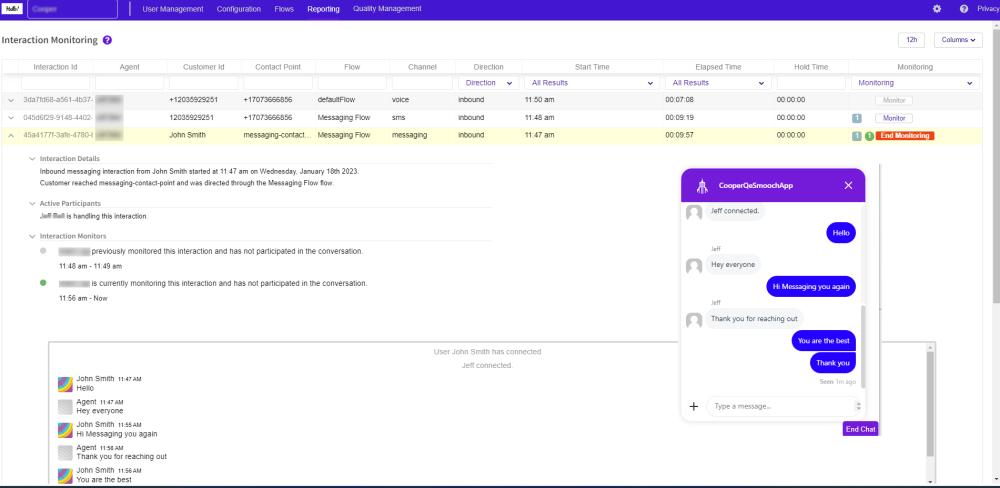
Known Issue: Currently CxEngage errors when multiple agents attempt to view the same interaction at the same time. This is a known issue and is being addressed.
Fix: Properly Display Text in Report Drop-downs and Column Headers (CXV1-28989)
Previously some reports in CxEngage > Reporting showed only part of the text in column headers and drop-down menus. This has been corrected and the information now displays properly.
| CxEngage Release 23.01.14 | |
|---|---|
| All Regions | January 14, 2023 12:00 - 15:00 UTC |
Update: Allowing Chat Customer to End a Conversation (CXV1-28901)
An End Chat option that allows a chat to be ended from the customer-side has been added to the Chat window. A customer can disconnect from the chat by clicking the end chat button at the bottom of the window. The interaction is terminated and the customer-side chat history is cleared.
Note: In CxEngage, Chat transcripts are available to review in Reporting > Historical Reporting.

Update: Addition of Hold Time to CxEngage
(CXV1-28955), (CXV1-28956), (CXV1-28957), (CXV1-28958)
Hold Time information has been added to CxEngage Reporting. Hold time is the length of time that passes while a customer and agent are in a call and the call is placed on hold by the agent. It displays in HH:MM:SS format.
Hold time information can be found in the Reporting > Realtime Dashboards > Interactions in Conversation Table and Reporting > Interaction Monitoring page.
Note: To see the Hold Time information, you may need to add the column to the grid. To add a column, click the Columns button, check the box for the column you want to add, and then click outside the column list to close the pop-up.
Update: Adding Custom Attribute Columns to Interaction Reports (CXV1-29007)
You can now show your custom attributes as columns of information on interaction reports in CxEngage. Previously, when configuring multiple custom attributes in a flow, all your information was stored in a single column, making it difficult for your analysts to read and filter reports. Now, each custom attribute can be displayed in its own column on the report, by attribute name, with the attribute values shown in the rows below.
When running a report in Reporting > Historical Reporting > Analysis, your custom attributes can display by individual columns in the Interaction Detail by Queue and Interaction Detail by Agent reports.
Note: You can add up to ten custom attribute columns to an interaction report.
To add a custom attribute as a column in an interaction report, follow these steps:
-
Go to Reporting > Historical Reporting > Analysis.
-
From the Select Data drop-down menu, select the interaction report with which you want to work, Interaction Detail by Queue or Interaction Detail by Agent.
-
Below the list of available report information, click the Select Data arrow and choose the appropriate Custom Attributes option from the list that pops up, Interaction Detail by Queue > Custom Attributes and Interaction Detail by Agent > Custom Attributes.
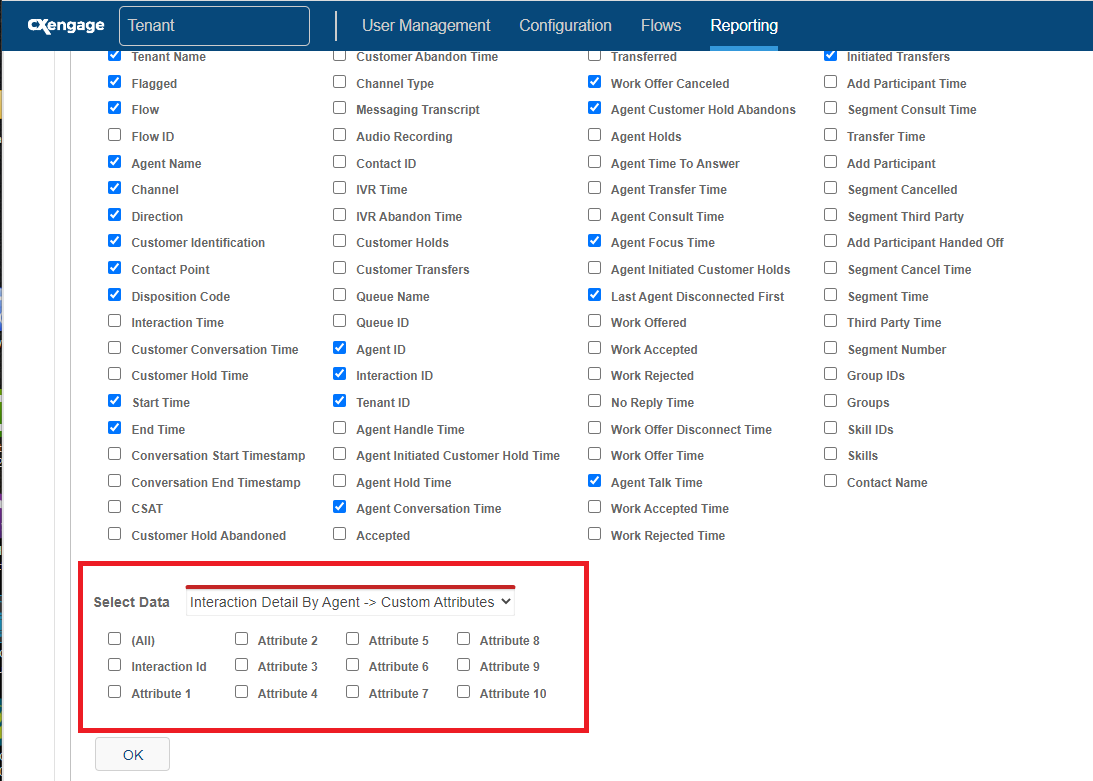
Ten general attributes display. You will map your information to these attributes.Map your Information to a General Attribute
On the Custom Attributes dialog, associate a general attribute, Attribute 1, Attribute 2, etc., with your existing information.
-
At the top of the page, click the Set Custom Attributes button.
-
Check one of the ten attribute boxes, and then click the Select an attribute arrow next to it.
-
From the list, select your existing custom attribute. Continue to check a box and select an attribute for each column you want shown on the report.
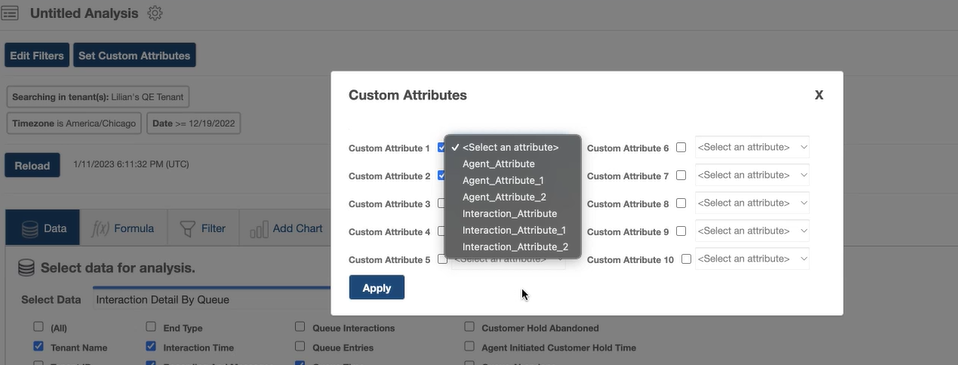
-
Click Apply to add your customized attributes to the interaction report details.
At the bottom of the page, notice that the Attributes you mapped reflect the name of your information rather than the general attribute name. -
Check the box next to each attribute name you want to add to the report as a column.
-
Click the OK button, and the report displays columns for your existing attributes.
